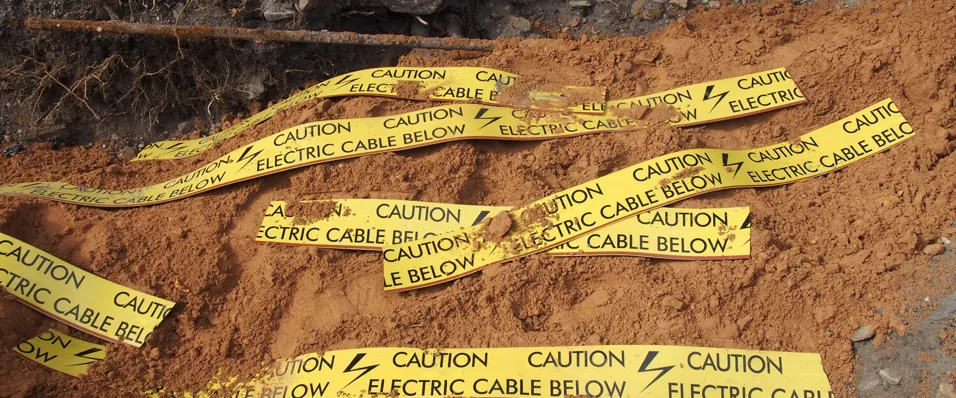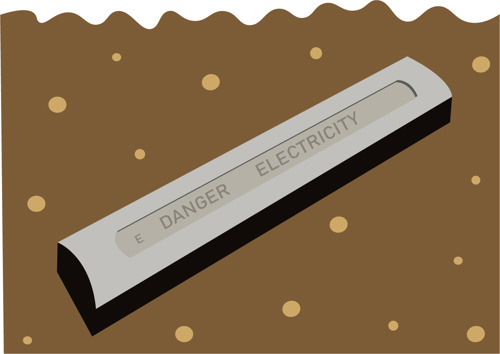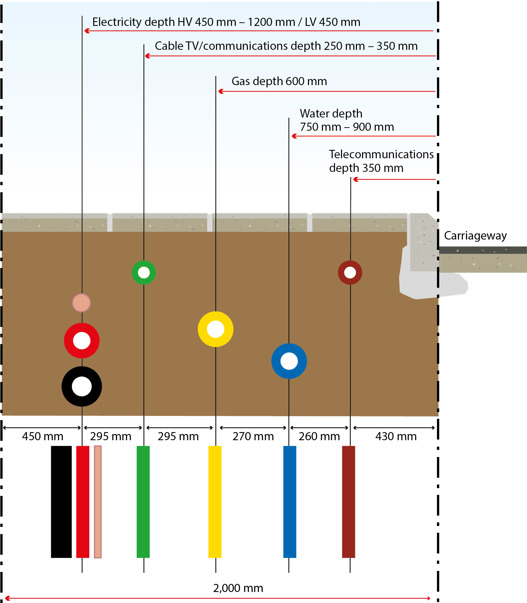
Buried conduits and ducts: Which conduits and ducts offer equivalent mechanical protection to armoured cables when buried in the ground?
By: Michael Peace CEng MIET MCIBSE
The use of unarmoured cables, such as HO7RN-F rubber flexible cables or unarmoured XLPE cables buried in the ground, is becoming more popular, especially for DC string wiring of photovoltaic (PV) systems and for certain interconnections in electric vehicle (EV) charging installations.
For such installations, it is necessary for the cables to have sufficient mechanical protection. This article looks at the use of such cables and the type of conduit and ducting that should be used where these cables are buried in the ground.
What are the requirements for cables buried in the ground?
Regulation 14(2) of the Electricity Safety, Quality and Continuity Regulations (ESQCR) 2002 and Regulation 15(2) of the ESQCR (Northern Ireland) 2012, require that all buried cables shall be installed at a sufficient depth, or otherwise protected, to avoid damage or danger.
For public and private electrical installations, Regulation 522.8.10 of BS 7671:2018+A2:2022 provides requirements for cables buried in the ground. Generally, a cable buried in the ground is required to incorporate an earthed armour or metallic sheath or both, suitable for use as a protective conductor.
The location of a buried cable is also required to be marked by cable covers (see Figure 2) or a suitable marker tape (see Figure 1).
Alternatively, Regulation 522.8.10 of BS 7671:2018+A2:2022 permits an unarmoured cable to be buried in the ground that is installed in a conduit or duct that provides equivalent protection against mechanical damage.
Which conduit and ducts offer equivalent mechanical protection to armoured cables?
The note to Regulation 522.8.10 of BS 7671:2018+A2:2022 cites BS EN 61386-24 as the standard for underground conduits. BS EN 61386 is titled, Conduit systems for cable management, Part 24: Particular requirements - Conduit systems buried underground. The word duct is not included in the standard. However, BS EN 61386-24 provides requirements for nominal sizes of ducts or conduits from 25 mm to 250 mm in diameter.
BS EN 61386-24 requires the conduit or duct to be marked to indicate the impact rating as detailed in Clause 6 of BS EN 61836-24:2010. Code L is used to identify light resistance to impact, whereas code N is used for normal resistance to impact. Following the resistance to impact rating, the resistance to compression code rating is required, ‘250’, ‘450’, or ‘750’ according to the resistance to compression.
Type N450 and Type N750 are intended to be directly buried in the ground without additional precautions. Whilst many N750 rated ducting solutions comprise rigid ducting, N750 rated flexible duct solutions are available.
What is the minimum impact and compression rating for conduit and ducts?
The minimum impact rating of N450 should be used for an unarmoured cable. The required impact and compression rating of duct will depend on the ground above and its intended use. For example, where heavy traffic is expected, a higher rating will be required but this becomes a matter for a civil engineer.
Section 5.10.3 of the IET Code of Practice for Grid-connected Solar Photovoltaic Systems recommends a buried conduit or duct should meet the classification of N750. This is the same specification for a duct required by distribution network operators (DNOs) and distribution system operators (DSOs) for public distribution network cables.
What does ‘suitably identified’ mean?
Regulation 522.8.10 of BS 7671:2018+A2:2022 states that buried conduits and ducts shall be suitably identified. Ducts are usually identified by colour according to the service, for example, black is used for low-voltage electricity, red is used for high-voltage electricity, yellow for gas and blue for water.
The Streetworks UK publication provides guidelines on colour coding of underground utilities. This publication is aimed at contractors working on public highways, such as work for a DNO’s network, but there is nothing to prevent the publication being used for general electrical installations.
What is suitable marking for buried cables?
Regulation 522.8.10 of BS 7671:2018+A2:2022 requires the location of buried cables to be marked by cable covers or a suitable marker tape. Cable covers or marker tape is laid above the buried duct or cables to provide an early warning that electric cables are present (see Figure 1 and Figure 2). Some marker tapes include a metallic strip which can be detected using a cable detection tool.
To offer additional mechanical protection, cable covers can be installed above ducts to provide an early indication there are electric ducts present (see Figure 2).
Figure 1: Cable marker tape

Figure 2: Concrete cable cover for buried cables

What are the sufficient depths for buried cables, conduits and ducts?
Buried cables, conduits and ducts shall be at a sufficient depth to avoid being damaged by any reasonably foreseeable disturbance of the ground. This may seem ambiguous but there are so many variables that it would be difficult to cover all situations. Essentially, it is an engineering judgment made by the designer of the electrical installation.
In some cases, particularly undeveloped land, land where a major construction redevelopment is taking place, or where the conditions are otherwise unknown, it may be necessary to commission a ground survey and/or take the advice of a civil engineering groundworks specialist.
The Streetworks UK publication also provides guidelines on recommended minimum depths for buried services in a 2 m footway (see Figure 2). For low-voltage cables, a minimum depth of 450 mm is recommended. As with identification, there is nothing to prevent installers choosing to use these depths for general electrical installations; however, this is not a requirement called for in BS 7671:2018+A2:2022.
Figure 3: Recommended minimum cable depths for footways

For installations where the ground preparation does not meet highway constructional standards, IET Guidance Note 1: Selection & Erection recommends a minimum depth of 500 mm to protect the cable from damage from ground movement and frost heave.
A summary of the various requirements and recommendations surrounding cable depth is provided in Appendix K to the IET Code of Practice for Electric Vehicle Charging Equipment Installation (see Table 1 ), and Appendix E to the IET Code of Practice for Grid-connected Solar Photovoltaic Systems.
Table 1: Minimum depth or burial of low and extra-low-voltage cables from Appendix K to the IET Code of Practice for EV Charging Equipment Installation, 5th Edition
| Area classification of ground under which cable is buried (NOTE 1) | Minimum depth of burial (NOTES 2 and 3) | References to requirements and guidance |
| General minimum depth (unless within ducts encased in concrete) | 0.5 m | Regulation 522.8.10 of BS 7671. Section 5.6 of IET Guidance Note 1: Selection & Erection |
| Agricultural (general, and including areas where livestock graze) | 0.6 m | Regulation 705.522 of BS 7671 |
| Agricultural (arable or cultivated ground) | 1.0 m | |
| Caravan sites | 0.6 m | Regulation 708.521.7.2 of BS 7671 |
| Marinas | 0.5 m | Regulation 709.521.1.7 of BS 7671 |
| Shore connection points for inland navigation vessels | 0.6 m | Regulation 730.521.101.3.2 of BS 7671 |
| Highway - footway, verge or bridleway (NOTE 4) | 0.5 m | Regulation 522.8.10 of BS 7671. Section 5.6 of IET Guidance Note 1: Selection & Erection Street Works UK Publication Volume 1 - Street Works UK Guidelines on the positioning and Colour Coding of Underground Utilities' Apparatus. |
| Highway - carriageway (NOTE 4) | 0.6 m |
NOTE 1: Where an area under which cables are buried may come under two classifications, the most onerous (deepest) minimum depth applies.
NOTE 2: Depth is to top of duct (or top of cable if cables with earthed metallic armour are directly buried).
NOTE 3: Where cables or ducts are buried in soft ground, the depths should be increased by 400 mm to account for ground compression from vehicles or machinery movement over wet or damp ground, frost heave, and sinking of soft ground.
NOTE 4: See also Table K.2 and Figure K.1.
In some special installations or locations, such as those detailed in Part 7 of BS 7671:2018+A2:2022, minimum depths of burial are specified. It should be noted that these are minimum depths, not targets, and deeper burial may be necessary in some cases to prevent damage by reasonably foreseeable disturbance of the ground. Such locations include:
- In Section 705 Agricultural and Horticultural Premises, Regulation 705.522 specifies a minimum depth of burial of 0.6 m, increasing to a minimum depth of 1.0 m for arable or cultivated ground.
- In Sections 708 Electrical Installations in Caravan / Camping Parks and Similar Locations, and 730 Onshore Units Of Electrical Shore Connections For Inland Navigation Vessels, a minimum depth of 0.6 m is required (see Regulations 708.521.7.2 and 730.521.101.3.2).
- In Section 709 Marinas and Similar Locations, Regulation 709.521.1.7 requires a minimum depth of 0.5 m.
Where cables or ducts are buried in soft ground, account should be taken of ground compression from vehicle or machinery movement over wet or damp ground, frost heave, and sinking of soft back-fill where trenches are dug.
Where armoured cables are not earthed
Earthed armoured cables are typically associated with the protective measure automatic disconnection of supply (ADS). If any of the live conductors come into contact with the earthed armour, the associated protective device disconnects the supply in accordance with Section 411 of BS 7671:2018+A2:2022. There would be no advantage providing earthed armouring for unearthed DC systems such as EV charging and the DC side of PV systems, in fact, doing so could create a hazardous situation.
For example, take a PV system and consider, if the armour was earthed to the AC system and it came into contact with a DC conductor, effectively it creates an earthed DC system. Regulation 712.312.2 permits earthing of one of the live conductors where there is simple separation between the AC and DC side. However, most inverters are transformerless inverters without simple separation.
The armouring of a cable is considered an exposed-conductive-part, therefore, it must be earthed. If the armour is unearthed and a live DC conductor from a PV string came into contact with the unearthed armouring, the armour would be live during daylight, at a voltage up to 1,500 V DC. With no method of disconnecting the supply, this is potentially a very dangerous situation.
The protective measure used for the DC side of PV systems is typically double or reinforced insulation in accordance with Section 412 of BS 7671:2018+A2:2022. The principle of this protective measure is that the insulation prevents live conductors coming into contact with each other and with metallic parts, reducing the possibility of short-circuit or earth faults occurring. The requirements in Regulation 712.521.101 of BS 7671:2018+A2:2022 and Section 412 are therefore clear, in that cables should have a non-metallic sheath, or be installed in insulated conduit or trunking and the risk of contact with earth minimized.
Are there any other considerations when using ducts?
It is important to seal the ends of conduits and cable ducts using an approved method for a number of reasons, such as, to prevent foreign objects or rodents entering the duct. Another issue that is often overlooked is natural gas and water can accumulate in underground ducts. Where there is a risk of gas entering a duct, a suitable gas proof seal should be used.
Where a cable is installed in a duct, it is possible that the duct will become waterlogged. Depending on the ground conditions, for example, where the soil has a high clay content, or where the depth of burial will place the cable or duct below the water table for long periods, consideration should be given to the suitability of the cables for continuous submersion. Where there is any doubt, the manufacturers of the cable and duct are best placed to advise.
On completion of any buried cable installation, it is important to record the details of the cable route, depth and method of protection. This is useful for any future works to prevent danger or damage to the buried services.
Safety
Before any excavation is undertaken for cable, ducting or other works, HSE guidance booklet HSG47 Avoiding danger from underground services should be followed, as it provides valuable advice on safety aspects. In many cases, it is advisable to commission or undertake an underground services survey according to PAS 128:2022 Underground utility detection, verification and location – Specification.
Summary
A cable installed in a duct should be installed at a depth where mechanical damage is unlikely to occur. The minimum rating of the conduit or duct that should be considered to offer the equivalent protection to armoured cables is Type N450 duct to BS EN 61386-24. However, some applications and standards require Type N750 ducts.
The rating and depth of ducting will depend on the ground conditions and the expected use. Where doubt exists, a civil engineer should be consulted.
Consideration should be given to the suitability of cables installed in ducts which may become waterlogged.
Ducts should be sealed at both ends to prevent mechanical damage, ingress of water or solids, gas accumulated in the ground from entering the building, or damage from fauna such as rodents or rabbits.
Armoured cables are not suitable for the DC side of unearthed PV systems where the protective measure is double or reinforced insulation.
Acknowledgements
- Bob Cairney
- Craig O’Neill
- Darren Crannis
- Frank Bertie
- Gary Gundry
- Graham Kenyon
- John Peckham
- Leon Markwell
- Mark Coles
- Peter Monfort (Arena Training)
- Roberts Lapsevskis.
